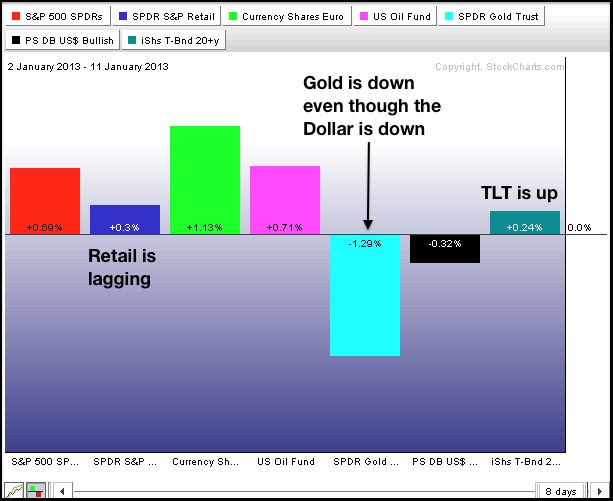After big moves on 31-Dec and 2-Jan, stocks edged higher the last seven trading days. The S&P 500 ETF (SPY) closed at 146.06 on Wednesday (2-Jan) and at 147.07 on Friday (11-Jan). Even though the ability to hold the initial gains and edge higher is positive, some interesting crosswinds are starting to appear. First, note that the 20+ Year T-Bond ETF (TLT) is also up since January 2nd. Treasuries should be down when stocks are up. Second, notice that the Retail SPDR (XRT) is lagging SPY with a smaller gain (.30% versus .69%). Relative weakness in retail is also a potential negative for the broader market. Note that December retail sales will be reported on Tuesday morning. Also note that the Fed will release its Beige Book on Wednesday. More details on the future of quantitative easing could affect stocks, treasuries, the Dollar and gold.





**************************************************************************

**************************************************************************

**************************************************************************

**************************************************************************

**************************************************************************
Key Reports and Events:
Tue - Jan 15 - 08:30 - Retail Sales
Tue - Jan 15 - 08:30 – Producer Price Index (PPI)
Tue - Jan 15 - 08:30 - Empire State Manufacturing
Wed - Jan 16 - 07:00 - MBA Mortgage Index
Wed - Jan 16 - 08:30 – Consumer Price Index (CPI)
Wed - Jan 16 - 09:15 - Industrial Production
Wed - Jan 16 - 10:00 - NAHB Housing Market Index
Wed - Jan 16 - 10:30 - Oil Inventories
Wed - Jan 16 - 14:00 - Fed Beige Book
Thu - Jan 17 - 08:30 - Jobless Claims
Thu - Jan 17 - 08:30 - Housing Starts/Building Permits
Thu - Jan 17 - 10:00 - Philadelphia Fed
Thu - Jan 17 - 10:30 - Natural Gas Inventories
Fri - Jan 18 - 09:55 - Michigan Sentiment
Charts of Interest: Tuesday and Thursday
This commentary and charts-of-interest are designed to stimulate thinking. This analysis is
not a recommendation to buy, sell, hold or sell short any security (stock ETF or otherwise).
We all need to think for ourselves when it comes to trading our own accounts. First, it is
the only way to really learn. Second, we are the only ones responsible for our decisions.
Think of these charts as food for further analysis. Before making a trade, it is important
to have a plan. Plan the trade and trade the plan. Among other things, this includes setting
a trigger level, a target area and a stop-loss level. It is also important to plan for three
possible price movements: advance, decline or sideways. Have a plan for all three scenarios
BEFORE making the trade. Consider possible holding times. And finally, look at overall market
conditions and sector/industry performance.

About the author:
Arthur Hill, CMT, is the Chief Technical Strategist at TrendInvestorPro.com. Focusing predominantly on US equities and ETFs, his systematic approach of identifying trend, finding signals within the trend, and setting key price levels has made him an esteemed market technician. Arthur has written articles for numerous financial publications including Barrons and Stocks & Commodities Magazine. In addition to his Chartered Market Technician (CMT) designation, he holds an MBA from the Cass Business School at City University in London.
Learn More